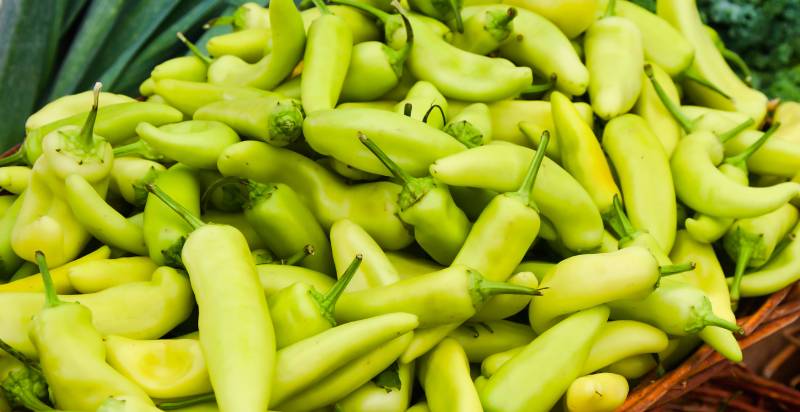The Hungarian wax pepper (Capsicum annuum) is a hot pepper grown and used in many cuisines worldwide. Its appearance and flavor make it a popular choice for adding spice to dishes, ranging from stews and soups to salads, salsa, and pickles. In this article, we’ll explore this unique ingredient’s history, uses, nutrition facts, and health benefits.
What is a Hungarian Wax Pepper?
Hungarian wax peppers are members of the Capsicum annuum species, which includes bell peppers, jalapenos, and chili peppers. They have a bright red or yellow color with thin walls, making them ideal for stuffing or slicing. The heat level of Hungarian wax peppers can range from mild to hot depending on the variety; some are even considered “super hots.”

History and Origin of the Hungarian Wax Pepper:
The Hungarian wax pepper, also known as the ‘hot banana pepper,’ is a variety of chili pepper originating from Hungary. It was first described in 1790 by German botanist Johann Anton Weinmann. The peppers have a mild and somewhat sweet flavor with just a hint of heat. They are often used to add color and flavor to many dishes and are popular in Hungarian cuisine. The peppers range from mild to hot, with the hottest varieties having on the Scoville scale.
The Hungarian wax pepper is believed to be of Capsicum annuum variety, including jalapenos and cayenne peppers. The name “wax pepper” is thought to come from the waxy appearance of the fruit’s thick skin. The peppers can range in colour from yellow to orange, red, or purple and are typically 4-6 inches long. They taste delicious with a very slight tinge of spice.
Appearance of the Hungarian Wax Pepper:
The Hungarian wax pepper is a medium-sized chili pepper with a bright yellow-orange color that turns red when mature. It has a thick, waxy skin and a mild to moderately spicy flavor. The peppers can grow up to four inches long and are typically 2-3 inches wide at the shoulder. When ripe, the pepper turns yellow to orange, finally red.
Flavor Profile of Hungarian Wax Pepper:
Hungarian wax peppers have mild to medium heat with a sweet and smoky flavor. They are often used as a substitute for jalapenos or banana peppers in dishes where less heat is desired. They can be eaten raw, pickled, cooked, or roasted.
Plant Characteristics of Hungarian Wax Pepper:
- Plant Size: Hungarian wax pepper plants typically reach heights of 1-2 feet and spread to 0.5-1 foot in width when fully grown.
- Leaves: The leaves are medium green with serrated edges, and the stems are woody and sturdy.
- Flowers: The flowers are small and yellow and tend to grow in clusters around the stem.
- Fruits: The fruits of Hungarian wax pepper plants are long and tapered. They start green but can turn bright yellow, orange, or red when fully mature.
- Heat Level: These peppers have a relatively mild heat level, ranging from 1,000 to 10,000 Scoville Heat Units (SHU). They are considered to be about the same heat as jalapenos.
Health Benefits of Hungarian Wax Pepper:
Hungarian wax peppers are a good source of vitamins and minerals. They contain vitamins A, C, potassium, iron, folate, and magnesium.Eating Hungarian wax peppers can help to support digestion by stimulating saliva production and increasing gastric juices. These peppers also act as natural laxatives to help with constipation.
Where is Hungarian Wax Pepper Grown and Harvested?
The United States, Mexico, and Central America are typically where Hungarian wax peppers are grown and collected. During the summer, farmers’ markets and supermarket stores tend to carry them the most. Planting the plants in well-drained soil with full sun will help them grow the healthiest.

Where can the Best Quality Hungarian Wax Pepper be found?
The best quality Hungarian wax peppers can be found at local farmers’ markets, specialty stores, and online retailers. Buying peppers that have a bright color and are firm in texture is important. Look for peppers free from blemishes and bruises, which will indicate freshness.
How to Use Hungarian Wax Pepper?
Hungarian wax peppers are a versatile ingredient that can be used in both sweet and savory dishes. They pair well with fresh fruits such as apples, pears, and strawberries, as well as vegetables like tomatoes, onions, mushrooms, squash, and zucchini. Here are a few suggestions for incorporating Hungarian wax peppers into your cooking:
- Roast Hungarian wax peppers with potatoes or carrots for a flavorful side dish.
- Chop up Hungarian wax pepper and add it to a taco salad for an extra kick of flavor.
- Mix diced Hungarian wax pepper with diced onion, garlic powder, salt and pepper to make a delicious relish for burgers or sandwiches.
These are just a few of the many ways that Hungarian wax peppers can be used to add flavor and heat to your cooking.
Storage Tips for Hungarian Wax Peppers:
Hungarian wax peppers are best when stored in the refrigerator, lasting up to two weeks. If you plan on keeping them longer, you can also freeze them. To do this, place washed and dried peppers in a resealable bag before freezing. When ready to use, thaw the peppers overnight and then proceed with your recipe.
Conclusion:
Hungarian wax peppers are a remarkably adaptable ingredient that may be utilized in a wide range of dishes, from spicily flavorful stews to delicious sauces. These peppers are ideal for flavoring your favorite foods because they can be stored and handled correctly and can last for weeks or months in the refrigerator. Hungarian wax peppers will definitely give your dish some zing, whether you like spicy food or not!
The information in this article should have helped you learn more about Hungarian wax peppers. Why not give them a try now that you are more knowledgeable about where they come from, how to keep them, and what dishes you can make with them? These peppers are so flexible that you might end up using them in all your favorite dishes!
Happy cooking!
- Everything You Wanted to Know About Red Tamarillos - June 2, 2025
- A Guide to Tulips: Everything You Need to Know & More… - June 2, 2025
- Guanabana: Description, Flavor, Benefits, And Uses - May 27, 2025

5 thoughts on “Hungarian Wax Peppers: Description, Flavor, Benefits, And Uses”
Comments are closed.